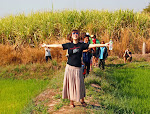
Ralph Waldo Emerson once said, “No man acquires property without acquiring with it a little arithmetic also.” After spending time living in several rural villages of Northeastern Thailand, I can assure you the villagers are acquiring more than their share of arithmetic. Last week, I stayed at the home of Poon Ded Prahgo and his wife in the small agricultural village of Toong Lui Lai. As part of a land unit in my Development & Globalization study abroad program through CIEE in Khon Kaen, Thailand, I’ve begun to study the history of land titles in Thailand. While it is sometimes hard to look at issues of property ownership without using the Western lens I’ve developed growing up in the United States, I’ve realized how unjust the current system of land titles in Thailand is to the people who have lived on the land for decades.
After forty-nine years on his land and with the transition to organic farming underway, it’s hard to understand why officers from the government’s local wildlife sanctuary recently threatened to cut down Poon Ded Prahgo’s trees under unsubstantiated charges of global warming and trespassing. “How can planting more trees cause global warming?” Poon questions. When Poon moved onto his land in 1963, his biggest fear was tigers. Tigers ate local dogs and instilled a sense of fear for personal wellbeing into the village. Now, in 2012, Poon’s biggest fear is of the Thai central government. The implementation of Western land ownership ideals instills a sense of fear for personal wellbeing and property into the Toong Lui Lai village. In February 2012, Poon traveled to Bangkok with the Isaan Land Reform Network to formally petition for his land rights. Government officials claimed land titles would be granted, but for now Poon and his wife continue to wait. “They have a pen and paper, they can sign whatever they want. We don’t have that pen. We have to suffer, we can’t fight back,” Poon says. Holding fast to his Thai heritage and his family values, Poon remains steadfast. “My neighbors, everyone knows I benefit from that land,” Poon says. With half a century on that land under his belt, Poon is not going anywhere, no matter how the tigers attack.
Thailand first introduced the concept of land titles in 1954, and even then the concept began in legislature without any formal structure for spreading the idea into rural areas like Toong Lui Lai. As Thai law begins to enforce a system of private property ownership akin to that of the United States, the Thai government must make significant changes to its current policy and strategy.
1) Communication must be inclusive to citizens in ALL parts of the country. Policy changes are reported in major newspapers, but these publications do not reach the rural villages of Isaan, the northeastern region of Thailand. Villagers have little means of communication outside of word of mouth and the occasional cell phone. Utilizing the same system of pick-up trucks with speakers announcing their wares used to sell goods in rural villages could be used to broadcast major government news. This change extends a positive impact even beyond land rights by creating a more well-informed populace on the whole.
2) Remember the various interest groups involved in the land rights issue. Private businesses, wildlife sanctuaries, governments at the local and national level, and thousands of citizens- each of these parties carries a distinct interest in the handling of private property and land distribution in Thailand. Hosting a forum held IN the communities where land disputes are occurring, with representatives from each of the aforementioned groups, could provide a step in the right direction for achieving widespread understanding.
At the crux of traditional land ownership and a politically-driven system of private property, the Thai government faces no small task in handling this issue. Most importantly, the villagers must have a voice. They have been attacked by tigers in their past, and it now seems as if other threats lie in wait for them. When communication and understanding become central goals in this process, villagers like Poon Ded Prahgo can begin to have a voice in the struggle for their land.
Molly Johnson
Texas Christian University



